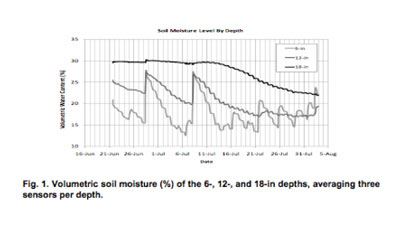Wireless Soil Moisture Monitoring
PORTAGEVILLE, MO.
Missouri has become a leader in wireless soil moisture sensors use by farmers. The benefit of wireless soil moisture monitoring is that a farmer can readily “see” the amount of moisture in his field to see if irrigation is needed or not. Cotton, a crop that suffers if either too little or too much water is applied, is a prime candidate for wireless monitoring.

A pivot-irrigated cotton field in Hornersville, MO was equipped with Decagon soil moisture sensors provided by Cotton Incorporated. The 6- , 12-, and 18-inch depths were monitored at three locations placed laterally (so they would all be watered together) in the 3rd, 5th, and 7th span of the pivot. Data was sent by cell phone modem to a WWW site and the farmer and MU personnel could observe the conditions which were updated about every four hours. Total cost was $3,943 and the annual cost was $7.40/ac/yr. The cooperators (Moore Farms) and Dr. Henggeler individually observed the plotted data from the sensors (Fig. 1). They would text back and forth regarding irrigating or not. One management strategy was not to allow the 18-in sensor to dry down very much early in the season. Figure 1 shows that this continued until mid-July, at which time the management strategy changed to keeping the 6- inch level hydrated, but allowing the 18-inch to dry down (like a drip irrigation system). The cooperators reported that this is one of the best fields of cotton on they have and they are putting on a bit more water than the normally do. Δ
DR. JOE HENGGELER: Irrigation Specialist, University of Missouri